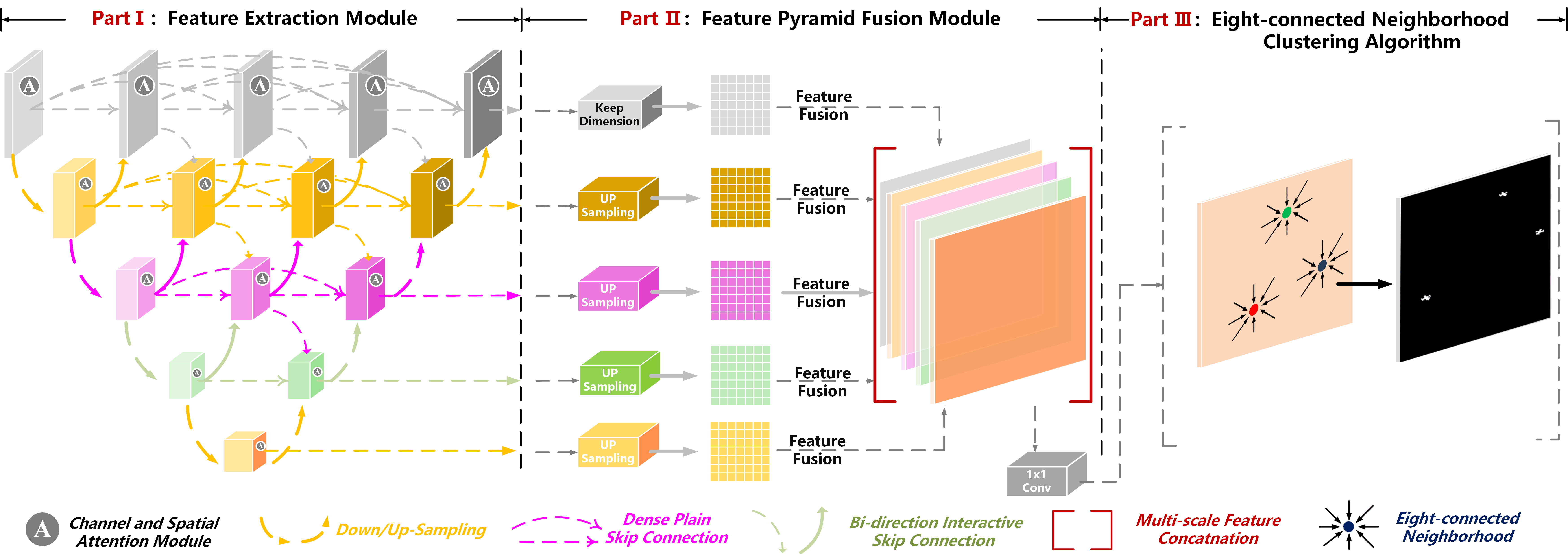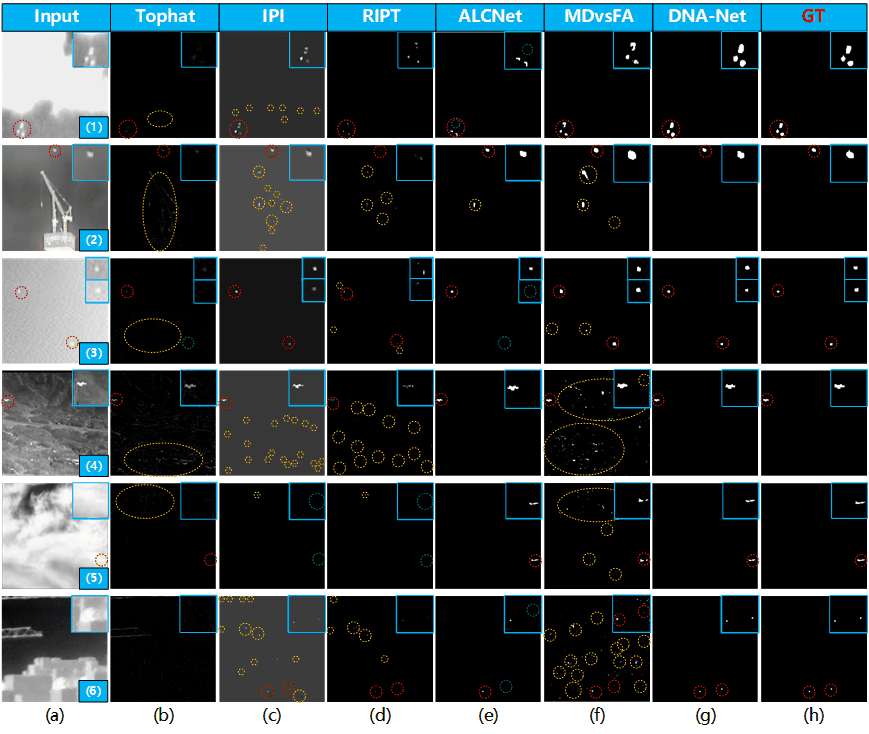Dense Nested Attention Network for Infrared Small Target Detection, Boyang Li, Chao Xiao, Longguang Wang, and Yingqian Wang, arxiv 2021 [Paper]
We propose a dense nested attention network (DNANet) to achieve accurate single-frame infrared small target detection and develop an open-sourced infrared small target dataset (namely, NUDT-SIRST) in this paper. Experiments on both public (e.g., NUAA-SIRST, NUST-SIRST) and our self-developed datasets demonstrate the effectiveness of our method. The contribution of this paper are as follows:
- We propose a dense nested attention network (namely, DNANet) to maintain small targets in deep layers.
- An open-sourced dataset (i.e., NUDT-SIRST) with rich targets.
- Performing well on all existing SIRST datasets.
NUDT-SIRST is a synthesized dataset, which contains 1327 images with resolution of 256x256. The advantage of synthesized dataset compared to real dataset lies in three aspets:
- Accurate annotations.
- Massive generation with low cost (i.e., time and money).
- Numerous categories of target, rich target sizes, diverse clutter backgrounds.
If you find the code useful, please consider citing our paper using the following BibTeX entry.
@article{li2021dense,
title={Dense Nested Attention Network for Infrared Small Target Detection},
author={Li, Boyang and Xiao, Chao and Wang, Longguang and Wang, Yingqian and Lin, Zaiping and Li, Miao and An, Wei and Guo, Yulan},
journal={arXiv preprint arXiv:2106.00487},
year={2021}
}
- Tested on Ubuntu 16.04, with Python 3.7, PyTorch 1.7, Torchvision 0.8.1, CUDA 11.1, and 1x NVIDIA 3090 and also
- Tested on Windows 10 , with Python 3.6, PyTorch 1.1, Torchvision 0.3.0, CUDA 10.0, and 1x NVIDIA 1080Ti.
- The NUDT-SIRST download dir (coming soon)
- The NUAA-SIRST download dir [ACM]
- The NUST-SIRST download dir [MDvsFA]
Click on train.py and run it.
python train.py --base_size 256 --crop_size 256 --epochs 1500 --dataset [dataset-name] --split_method 50_50 --model [model name] --backbone resnet_18 --deep_supervision True --train_batch_size 16 --test_batch_size 16 --mode TXTpython test.py --base_size 256 --crop_size 256 --st_model [trained model path] --model_dir [model_dir] --dataset [dataset-name] --split_method 50_50 --model [model name] --backbone resnet_18 --deep_supervision True --test_batch_size 1 --mode TXT python visulization.py --base_size 256 --crop_size 256 --st_model [trained model path] --model_dir [model_dir] --dataset [dataset-name] --split_method 50_50 --model [model name] --backbone resnet_18 --deep_supervision True --test_batch_size 1 --mode TXT python test_and_visulization.py --base_size 256 --crop_size 256 --st_model [trained model path] --model_dir [model_dir] --dataset [dataset-name] --split_method 50_50 --model [model name] --backbone resnet_18 --deep_supervision True --test_batch_size 1 --mode TXT python demo.py --base_size 256 --crop_size 256 --img_demo_dir [img_demo_dir] --img_demo_index [image_name] --model [model name] --backbone resnet_18 --deep_supervision True --test_batch_size 1 --mode TXT --suffix [img_suffix]on NUDT-SIRST
| Model | mIoU (x10(-2)) | Pd (x10(-2)) | Fa (x10(-6)) | |
|---|---|---|---|---|
| DNANet-VGG-10 | 85.23 | 96.95 | 6.782 | |
| DNANet-ResNet-10 | 86.36 | 97.39 | 6.897 | |
| DNANet-ResNet-18 | 87.09 | 98.73 | 4.223 | |
| DNANet-ResNet-18 | 88.61 | 98.42 | 4.30 | [Weights] |
| DNANet-ResNet-34 | 86.87 | 97.98 | 3.710 |
on NUAA-SIRST
| Model | mIoU (x10(-2)) | Pd (x10(-2)) | Fa (x10(-6)) | |
|---|---|---|---|---|
| DNANet-VGG-10 | 74.96 | 97.34 | 26.73 | |
| DNANet-ResNet-10 | 76.24 | 97.71 | 12.80 | |
| DNANet-ResNet-18 | 77.47 | 98.48 | 2.353 | |
| DNANet-ResNet-18 | 79.26 | 98.48 | 2.30 | [Weights] |
| DNANet-ResNet-34 | 77.54 | 98.10 | 2.510 |
*This code is highly borrowed from ACM. Thanks to Yimian Dai.
*The overall repository style is highly borrowed from PSA. Thanks to jiwoon-ahn.
- Dai Y, Wu Y, Zhou F, et al. Asymmetric contextual modulation for infrared small target detection[C]//Proceedings of the IEEE/CVF Winter Conference on Applications of Computer Vision. 2021: 950-959. [code]
- Zhou Z, Siddiquee M M R, Tajbakhsh N, et al. Unet++: Redesigning skip connections to exploit multiscale features in image segmentation[J]. IEEE transactions on medical imaging, 2019, 39(6): 1856-1867. [code]
- He K, Zhang X, Ren S, et al. Deep residual learning for image recognition[C]//Proceedings of the IEEE conference on computer vision and pattern recognition. 2016: 770-778. [code]
Upload NUDT-SIRST

